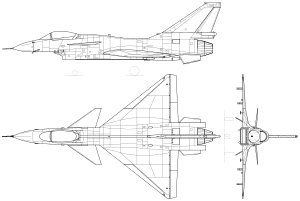Difference between revisions of "F-17"
o>Ayzek m (1 revision imported) |
m (1 revision imported) |
(No difference)
| |
Latest revision as of 11:27, 21 October 2018
| F-17 | |
|---|---|
| Lua error: Internal error: The interpreter exited with status 127. | |
| Role | |
| Manufacturer | Imperium Aerospace |
| Introduction | 1562 |
| Retired | n/a |
| Status | operational |
| Produced | 62 |
The Imperium Aerospace F-17 Vesparum(Wasp) is a twin-engined supersonic, all weather multirole combat jet. Designed by Imperium Aerospace with cooperation from Severyane and Oslanburg as a development of the F-5. The F-17 has a top speed of Mach 2.2 and can carry a wide variety of bombs and missiles. It is powered by one blank turbofan engines and is configured with a delta wing and canard design, with fly-by-wire flight controls. The Imperial Republic uses the F-17 for a wide variety of different roles such as, fighter escort, Suppression of Enemy Air Defenses (SEAD), air interdiction, close air support and aerial reconnaissance.
Contents
Design
Airframe
The airframe of the F-17 is constructed from metal alloys and composite materials designed for high strength and low weight, with a tail-less canard delta wing configuration, as the aerodynamic layout. A large delta wing is mid-mounted towards the rear of the fuselage, with a pair of canards mounted to the front and up of the fuselage, behind and below the cockpit. Uitilization of this configuration gives the J-17 very high agility, especially at low speeds, and also reduces stall speed, allowing for a lower airspeed during instrument approaches. A large vertical tail is present on top of the fuselage and small ventral fins underneath the fuselage provide further stability.
The cockpit is covered by a two-piece bubble canopy providing 360 degrees of visual coverage for the pilot. The canopy lifts upwards to permit cockpit entry and exit. The controls are "hands on throttle and stick" (HOTAS) which provide the pilot with a higher level of comfort. A zero-zero ejection seat is provided for the pilot, permitting safe ejection in an emergency even at zero altitude and zero speed.
Avionics
The cockpit had three liquid crystal (LCD) Multi-function displays (MFD) along with a Drah developed holographic head-up display (HUD), all of which are fully compatible with an advanced helmet mounted sight (HMS).
Due to the aerodynamically unstable design of the J-17, a digital a digital quadruplex-redundant fly-by-wire (FBW) flight control system (FCS) aids the pilot in flying the aircraft. The FCS typically monitors pilot control inputs, preventing the pilot from accidentally exiting the flight envelope from applying too much control input during high performance flight situations. This is critical in canard wing aircraft, as they are capable of turning in a much tighter radius than conventional aircraft. The massive control surfaces are capable of moving so far that they can completely destroy the aircraft in flight at high airspeeds if not kept in check by the FCS.
Radar and Sensors
The F-17A uses a multi-mode fire-control radar designed in Drahen. The radar has a mechanically scanned planar array antenna and is capable of tracking 10 targets. Of the 10 targets tracked, 2 can be engaged simultaneously with semi-active radar homing missiles or 4 can be engaged with active radar homing missiles.
The F-17C contains a active phased array airborne (AESA) radar in a redesigned nosecone. It is capable of tracking up to 40 targets, and engaging 10 simultaneously. In addition to the new radar, the aircraft is mounted with a electro-optical sensor turret with ISRT, aft of the radar dome. In addition, it is equiped with an electro-optical targeting pod, allowing for precision guided munitions to be dropped.
Propulsion
The F-17 is powered by either a Severyanian [blank] turbofan engine with a maximum thrust of 125 kN with afterburner, or a Drah [blank] turbofan, developed for the F-17, with a maximum of 130 kN of thrust with afterburner.
Weapons and external loads
The aircraft's internal armament consists of one Severyanian [something] 23 mm twin-barrel cannon, located under the port side of the intake. Other weaponary and equipment is mounted on one of the 11 external hardpoints, which can carry up to 6,000 kg (13,228 lb) of either missiles and bombs, drop-tanks containing fuel, or other equipment such as avionics pods. In addition a refueling probe is mounted to the front left of the nose cone, allow the aircraft to receive fuel in-flight.
Variants
- F-17A: Single seat multi-role variant.
- F-17B: Two seat trainer
- F-17C: An upgraded F-17, featuring a lighter and stealthier diverterless supersonic inlet, a longer nose radome possibly housing an active electronically scanned array radar, an electro-optic targeting sensor (IRST, and laser rangefinder,) and a new electronic warning or countermeasures pod atop the vertical stabilizer. First flight occurred in 1570, Drahen is currently the only operator
Specifications (F-17A)
- Crew: one
- Length: 15.49 m (50.82 ft)
- Wingspan: 9.75 m (31.99 ft)
- Height: 5.43 m (17.81 ft)
- Wing area: 39 m² (356.3 ft²)
- Empty weight: 9,750 kg (21,495 lb)
- Loaded weight: 12,400 kg (28,600 lb)
- Max. takeoff weight: 19,277 kg (42,500 lb)
- Powerplant: 2 × afterburning turbofans
- Dry thrust: 89.17 kN
- Thrust with afterburner: 130 kN
- Maximum speed: Mach 2.2 at altitude, Mach 1.2 at sea level
- Range: 1,200 km (745 mi), without refueling
- Combat radius: 550 km (342 mi), without refueling
- Ferry range: 1,850 km (1,150 mi), without refueling
- Service ceiling: 18,000 m (59,055 ft)
- Rate of climb: 285 m/s (56,102 ft/min)
- Thrust/weight: 1.17
- Max. maneuvering load factor: +9/–3 g
- Guns: 1× 23 mm cannon, 430 rounds
- Hardpoints: 11 in total (6× under-wing, 5× under-fuselage) with a capacity of 7,000 kg (15,400 lb) external fuel and ordnance
